At the Global Impact Summit sponsored by HolonIQ, educational trends setting the tone for the future of learning were discussed, such as the recognition and adoption of alternative credentials, omnichannel learning, the development of digital skills, and the vision of lifelong learning.
The event took place on September 28 and 29 at the Mexico City Campus of Tecnologico de Monterrey in partnership with the Institute for the Future of Education of Tecnologico de Monterrey, Google Cloud, the Inter-American Development Bank Lab and Edi (Education + Innovation + Capital @LATAM).
HolonIQ is a global network with advanced research technology that generates impact market intelligence through its platform. Maria Spies, its co-CEO, recognized at the summit that digital adoption and transformation comprise the biggest challenge in higher education, so developing digital skills is critical. Access should be a priority for educational institutions, and paying attention to retention, low student enrollment, and budget cuts is crucial. The changing needs of the workforce must also be considered because they present a continuing challenge.
Hone and learn new skills
Ignacio Gómez Portillo, CEO and founder of Egg, and Julián Melo, CEO and co-founder of UBITS, pointed out that graduates generally do not have the skills the companies require. This talent gap is accentuated in Latin America, where the majority of young people do not have access to a university degree, and only a tiny percentage possess the necessary skills for companies.
Organizations have an internal demand for people who want to improve their professional and personal careers. Therefore, focusing on skills and developing competencies is paramount; employees can pursue alternative credentials, go to boot camps to increase remuneration, or identify the required teamwork skills and complete the related courses.
The learning acquired today will be obsolete in some years. Creating an integrated network of certification programs in universities plays a predominant role in improving employability; educational institutions and education technology companies must complement each other. EdTech (educational technology) start-ups help universities demonstrate flexible, dynamic programs.
Outskilling (or outplacement) consists of training employees who are likely to leave the company because their work will become automated. Many companies are considering this training, due to the pandemic and the start-up crisis that caused many people to experience downward economic cycles. Julián Melo proposed that aware organizations can train not only for work but prepare people who have to leave for an effective transition with valuable skills.
Educational technologies that seek to democratize education
The event featured speakers who innovate in the education sector to share their work and experiences. For example, Dionisio Garza Sada, CEO and founder of Talisis, emphasized that by seeing education as an ecosystem, various offerings, platforms, and segments come together, which creates personalized learning paths that give students the tools they require. Consumer-oriented education services help tear down inter-agency barriers.
Accessibility requires an omnichannel model of learning; the student’s academic experiences occur in classes with different formats, for example, face-to-face, virtual or hybrid. With consistent planning, teaching accommodates their soft and hard skills profiles.
Martha Belden, Vice President of Growth at Platzi, explained that people are lifelong learners. It is no longer merely about applying for university degrees but the skills complementing them. The challenge is how to convince mothers and fathers that their children no longer need to have a degree.
Anabella Laya, CEO and founder of Acreditta, mentioned that the platform’s purpose is to transform how academic records are identified so that each person owns their credential. Because of the manipulation and falsification of titles, certification management has more value. Not everyone has digital wallets, so it is easier to receive certificates by email. Democratizing education through personalized content (with corresponding recognition) is a short-term goal.
Valeria Guedes, the Latin America director of Labster, which has simulations of science laboratories, said that micro certifications help teachers improve and make their curricula more robust. Portfolios are also practical as they provide evidence of what students can do. In the future, portable learning records will significantly benefit their interoperability. She added that, in her experience, “trial and error is the path to active learning.”
Viviana Zocco, CEO and founder of TICMAS, pointed out that technology can help predict behaviors that reduce school dropouts. With personalized learning projects, students not only consume content but become its producers and use it to build. Tracy Bryan, the STEAM Coordinator at The American School Foundation, suggested that an institution’s technology plan should not consider just five academic years but the thirteen years of study from preschool to high school. Not all educational technology models fit individual schools, so it becomes necessary to find the one that works efficiently for each.
Mariana Litvin, director of the Idea Lab at Colegio Olamí ORT, defined educational technology as tools, elements, or processes that improve the institution’s productivity. To build an innovative education, universities must employ techniques that foster students’ curiosity and include disruptive methodologies. In addition, one must consider that the assumption that children like technology is not always the reality.
Learning throughout life
Michael Fung, Executive Director of the Institute for the Future of Education (IFE), said there is usually investment in post-secondary education but very little in the continuing education system after it. A system is needed that provides multiple pathways and is accessible and agile for formal and non-formal students, thereby redirecting investment and operations to a lifelong model that supports those who cannot achieve high qualifications. Continuing to train the workforce is essential; alternative credentials and stackable certifications help recognize new ways of learning.
Educational institutions must create flexibility for four-year students pursuing a university degree curriculum and those studying for just two weeks. An educational system with a new permanent paradigm must guarantee options for developing soft and hard skills.
José Escamilla, Associate Director of the Institute for the Future of Education, indicated that the educational institution is delimited by a series of guides that propose a transversal model that is faithful to its purpose, accessible, inclusive, and responsive (FAIR). Universities and industry must accelerate their responses to societal challenges. Education requires interdisciplinary teams to scale imaginative solutions to overcome its challenges.
Also, Arizona State University (ASU) presented various projects comprising its results-based lifelong learning ecosystem. The university seeks to teach everyone in the community through its vision: fostering and growing universal access to social and economic opportunities. Some of their programs include upskilling and reskilling courses, career catalysts with professional portfolios, and the “Mirabella” retirement community at the center of its facilities.
100 most promising EdTech start-ups in Latin America and the Caribbean
During the event, the 2022 Latin America EdTech 100 list was announced. It is one of the compilations made each year by region of the 1,000 most promising, young, fast-growing, and innovative start-ups globally. The considerations to determine the 100 most significant start-ups in Latin America and the Caribbean are that the ventures are under 10 years of age, their geography, scope, control of their shareholders, and standard exclusions.
The methodology for selecting the list members considers the market, product, equipment, capital, and the company’s momentum over time. Educational technologies are divided into categories: advanced technology, management systems, human resources and skills, language learning, online learning, STEAM, and tutoring and exam preparation. These start-ups set a benchmark in EdTech and the future of education.
Among several leaders of start-ups with an educational focus and actors in the sector, a common goal stood out: accessibility. With strategies, programs, and courses, each from his trench looks for ways to incorporate an inclusive vision of lifelong learning that guides full personal and professional development and is constantly updating.
Translation by Daniel Wetta
This article from Observatory of the Institute for the Future of Education may be shared under the terms of the license CC BY-NC-SA 4.0 
)
)


)